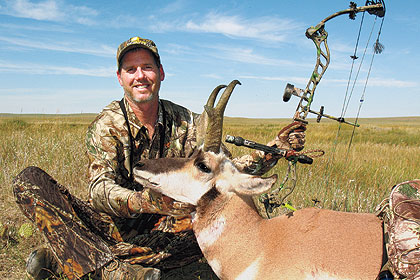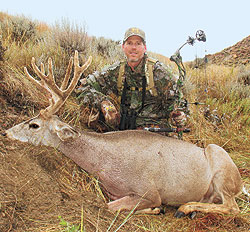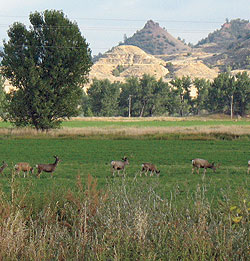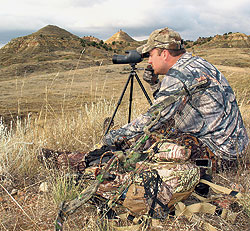October 28, 2010
By Patrick Meitin
Bowhunting paradise in the most unlikely of places.
By Patrick Meitin
Tripping across the exposed bench of summer-worn grass, scouring the rock-sterile rim above for any small movement, I ventured a glance down a low swale. There were antlers -- tall, wide and fuzzy with velvet -- jutting above low sage at the edge of a shallow coulee.
It was the muley we'd discovered bedded in hard shadow some sweaty miles past and ghosted until he'd mounted this serrated rim, the last before he'd reach the wide grass plain and join hordes of game that migrated daily from the forsaken badlands to feed in alfalfa fields along Eastern Montana's Powder River. There, on those wide fields, congregated an incredible array of mule and whitetail deer with the cool of evening, not to mention growing herds of pronghorn just beginning to rut this early in September.
Advertisement
I hissed. Todd Gardner, my young but seasoned guide, understood the universal code and dropped without question five yards ahead. I pointed, marveling that we'd not been discovered, nocked an arrow and dug out my rangefinder. The buck was close, and shooting was certain. I suddenly felt very wise. The others had opted for wet whitetail stands, but after a day in the air and three hours in a hurtling automobile, sitting wasn't something I was prepared for.
I could've taken a shot any time. Yet I wanted to know the range absolutely. I couldn't get a laser pop through a couple spindly sage and bouquets of broom-grass, even after exposing myself by small degrees. I tossed Todd the unit, hoping a different angle would provide a clear shot. He had no better luck. Finding an outcrop at the coulee's far bank, I signaled for the unit's return, got a number and was faced with guessing how much to subtract for the distance that really mattered.
Advertisement
Suddenly, the buck was moving.
I dropped the unit and jerked to anchor, the buck emerging in a seeming lunge. He had us, but I was on him -- vacillating. Let's call it 40. I centered lungs, providing a safe margin in these uncertain times. The string slipped away and I knew it was doomed. An explosion of hair blossomed from the very apex of his back. He was already in motion, departing but not gone to pieces. He paused at 70 yards, again at 90, and then was gone over a rise.
"When the @^#% did I get so dependent on this *^$@(&% technology?" I spouted. I stepped it off over broken ground, stomping the deep departure scars in moist soil.
Thirty-four.
Obsession
The following morning dawned cold and drizzly. At my request, Todd turned me loose.
I've always done my best work alone. Powder River Outfitters' owner, Doug Gardner, has several hundred square miles of leased ground available, providing plenty of options. But I had only one piece of ground in mind. I had a score to settle.
I'd been lulled by that initial encounter into believing this might be easy. I was all wrong. The next morning, I stalked within 96 yards of "my" buck, watching him strip away antler velvet as I waited. He followed a group of does that proceeded through a saddle, each pausing at 30 yards before continuing. The buck, for reasons known only to him, slipped away, absorbed by open terrain.
I found him another evening with three bucks of almost equally impressive dimensions.
They fed in a smooth dip, and I used a point of rock and scrub to close the distance quickly as a stiff wind drove sleet and freezing rain into my skin like darts. At 56 yards (some of the others were closer) I exhausted my cover, a closer buck eyeing me suspiciously despite raging weather. I couldn't even begin to guess wind-drift compensation. So, I waited. The nervous buck took the others with him, out onto open ground miles wide.
Change Of Pace
The racing storm washed the skies clean, making way for sunshine -- if for just a single day. An editor from another bowhunting magazine, Joe, and I concurred it would be our fleeting chance to punch pronghorn tags.
It was chilly in that Double Bull pop-up blind waiting for day to establish itself; not quite shivering, not quite comfortable. By mid-morning, I was stripping layers and struggling to imagine a chill crossing those rolling plains again. Pronghorn stirred. I guarded water 40-some yards away. At perhaps 10, a small buck tripped in, nosing a secreted depression 25 yards out. He was just pushing Pope and Young minimums and awfully tempting, but the sun continued to hammer the blind, and it was easy to imagine bigger prizes. After all, I had an entire three hours.
 This eleventh-hour pronghorn goat was taken on the single gorgeous day spent in Eastern Montana. The remainder of the hunt proved wet and chilly, making tedious spot-and-stalk the only option. In all, Meitin felt lucky to have tagged this one. |
I watched three bucks for the remainder of that time, one of them pushing Boone and Crockett, tossing every bit of Extra Sensory Perception I could muster his way in an effort to draw him closer. I'd convinced myself it wouldn't happen when he seemed suddenly struck by the idea of visiting my waterhole. Forty-two yards, broadside.
I'd pondered the shoot-through screens all morning and even tinkered with them momentarily in an unsuccessful attempt to roll them up and out of the way. Had the blind belonged to me, a knife would've sufficed. I had fresh experience to draw upon, but there were only turkeys at issue, and it was easy to laugh that one off.
This time, when two inches of screen-deployed mechanical blades sent my arrow into a wild tailspin, I was truly enraged. I was upset enough that when another buck arrived half an hour past scheduled pick up, I tried my luck again. The buck was a bit closer, the broadhead a different design, wearing a cutting tip that would punch through the netting more efficiently. He was a respectable buck, nipping P&Y minimums.
 Though author Meitin is plenty proud of his hard-earned muley buck, it did come as sort of a consolation prize on the final day compared to the bigger buck he missed the first day and then set his sights on for the remainder of the hunt. |
I'm certainly not proud of what followed, but include it by way of warning. Sparing the gory details, I'll just say I shot that buck four times -- three through screen which, let's just say, didn't find the 10-ring. I was finally able to rip out of the blind and pinwheel him at a ranged 68 yards. Certainly more merciful than a pack of winter coyotes, but not exactly living up to my end of the contract.
I'd learned to live with it by the time Todd and Joe arrived. Joe also had a nice pronger buck to brag about, nearly the twin of my own. Two book bucks in a day are certainly better than none.
Back In The Game
With that, I was back in the mule deer game. Spot-and-stalk mulies are much the same everywhere -- the common denominators being optics, wind, terrain and swift but careful feet. Eastern Montana offered the added facet of timetables dictated by traveling bucks accessing or departing known, widely separated destinations, though "destinations" comprised the Powder River Valley entire or a long line of rugged hills and rims not exactly representing precise map points. To complicate matters, bucks didn't adhere to a predictable set of waypoints to and fro. It was random enough to give statisticians the screaming fantods.
To level the playing field, you find a commanding vantage point and put optics to work.
Then it's time to stash gear, don your "stalking slippers" (Cabela's Baer's Feet, Rancho Safari's CatProwlers or PSE's Sneeky Pete Feet, for instance) and make time. In Eastern Montana, you shadow and wait for your opportunity. This normally means a buck that has just mounted a rise, fallen over the edge of a rim or into a coulee head, temporarily blind to his surroundings.
 Optics are the name of the game anywhere mule deer are stalked. Eastern Montana's rich and rugged history oftentimes provides interesting rests to steady binoculars while watching a distant deer descend from ragged, forsaken hills to feed. |
Optics help carry you across miles of broken hillsides and rugged canyons effortlessly and painlessly; covering in minutes what would otherwise require days. The goal is to find a target animal worthy of a considerable investment of time and effort. In that Montana Powder River country, that meant sorting through a plethora of possibilities, looking for that buck among many that obviously stood out. In my case, this meant seeking my proverbial Moby Dick.
Once The One is discovered, before all else, pause to formulate a sensible approach according to prevailing winds or the animal's course. Study the terrain your animal(s) seem(s) intent on, noting landmarks that will help you stay the course. If you're very lucky, you might observe your buck bed, allowing a more deliberate if highly challenging stalk. When animals are traveling, you'll be forced to proceed more aggressively, using topography to set up an ambush or arriving where appropriate cover tips the odds in your favor. There will normally be a single place along a long travel route where your chances of closing the distance are best.
 Large herds of mule deer descend from the high-country badlands to feed in alfalfa fields along Eastern Montana's Powder River. The trick for bowhunters is finding a good buck and figuring out a way to intercept him on his way between feeding and bedding areas. |
This is when you seize the opportunity, aggressively (and quietly) arriving on the scene before that momentary advantage evaporates. Bedded bucks require more patience -- crawling, slipping ahead a few yards at a time, waiting, employing optics, slithering ahead a bit more. Once in range, an even higher degree of patience is normally required -- waiting for that buck to stand or stretch before taking your shot. That wait can turn into seeming centuries.
Checkmate?
Given my time constraints and weather that matched my foul mood, when I discovered the laggard buck that suddenly sprouted from featureless earth it seemed imperative I try him. He wasn't the buck I had set my sights on during the long week -- not even close -- but he was the last in velvet and certainly nothing to get snooty about.
There was but a single problem. Well, two problems, really. Circling well around took care of the wind issue. The final issue, lack of cover, remained. So, I crawled. Did I mention kneepads earlier? Add that to your list of mule deer gear. In Montana, it's squat, sneaky little prickly-pear cacti; elsewhere, it might be sharp rock or simply banked clay. Trophyline makes a set of kneepads perfect for bowhunters.
And I crawled. An hour later, I "crested" the lip of a wandering wash -- something that had appeared of little use earlier until there simply were no other real options. I used a small sage scrub as cover while conducting a discouraging laser pop. It's easy, under the influence of adrenaline, to talk yourself into a great many things. You've made this shot thousands of times (in the relaxed backyard).
 The open country surrounding Eastern Montana's Powder River Valley is beautiful but unforgiving. A good spotting scope is a must for locating mule deer and judging their trophy potential before a long, grueling stalk is undertaken. |
You'd only have to hold off a bit for wind, and your pin would still be on the edge of vitals (I think). It's wide open enough that he'd be hard pressed to get out of sight if things don't go perfectly (which happens even at 20 yards). Let's get to full draw, get some pins on him and see how it feels (you know, just to see).
I sucked in a deep breath, drew my trusted BowTech Constitution low behind that stingy cover, bowed like a genuflecting monk, rose slowly on my knees, settled the correct pin on him, observed it steady, felt the calm, released half a breath and went through that one-second, mental checklist requiring minutes to recite. And it did feel good, and my confidence remained intact. So, I let it go.
The buck took three hops and tumbled out of sight over the lip of the opposite coulee crest. I'd lost my arrow in flight and imagined a spine hit. I snatched another arrow from my CatQuiver and nocked it on the run, reaching the rim to find empty grass and panic flowing through me. Shortly, I spotted him 50 yards below, finished, beautiful, another eleventh-hour prize to remember my time in Montana by.
Author's Note: For more information on Powder River Outfitters' combo bowhunt opportunities, contact Doug Gardner at 406-427-5721 or pat@davegardnercpa.com. You can also check out their website at www.powder-river-outfitters.com.
